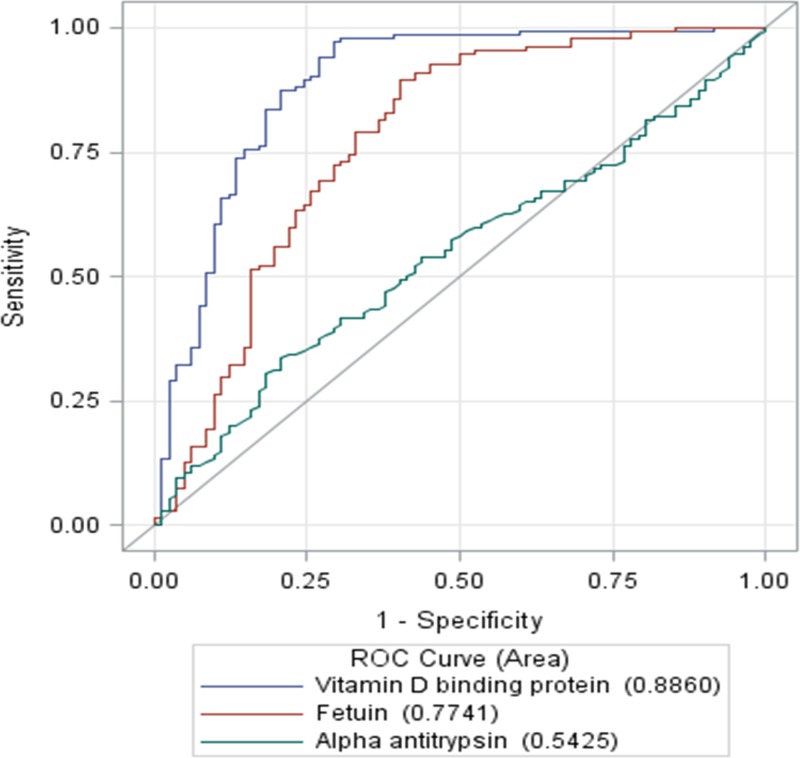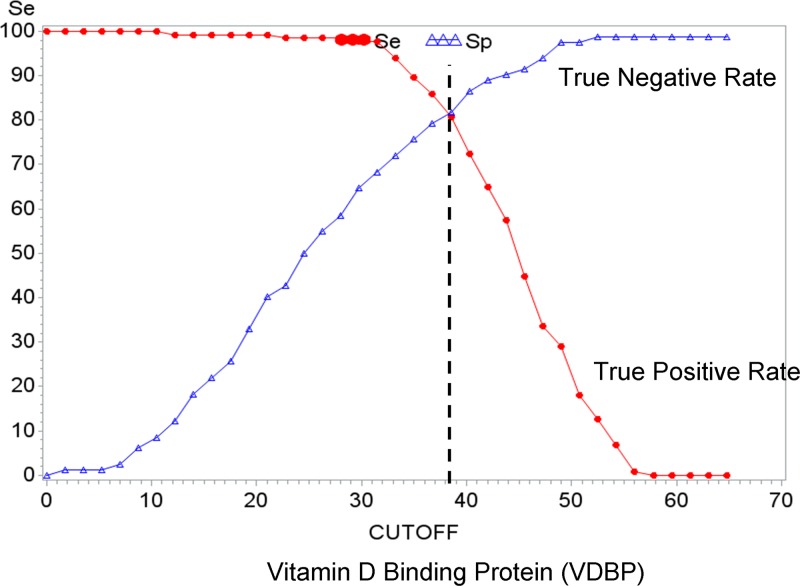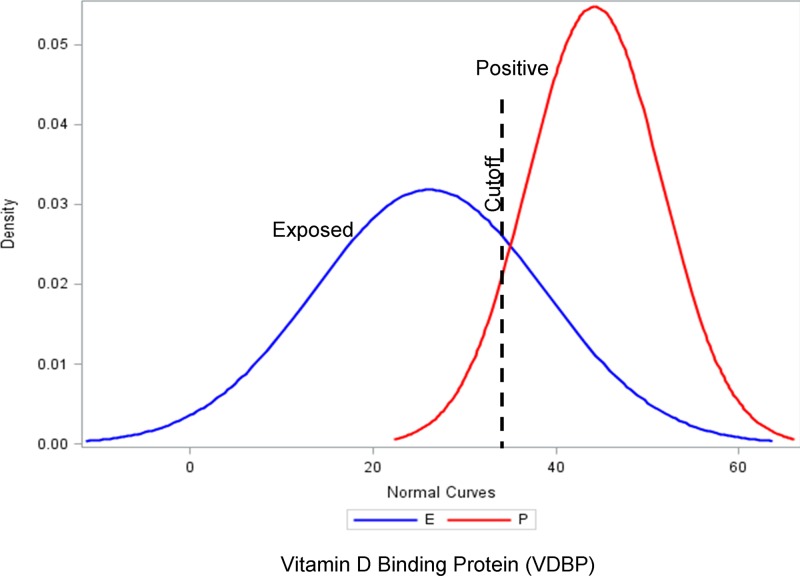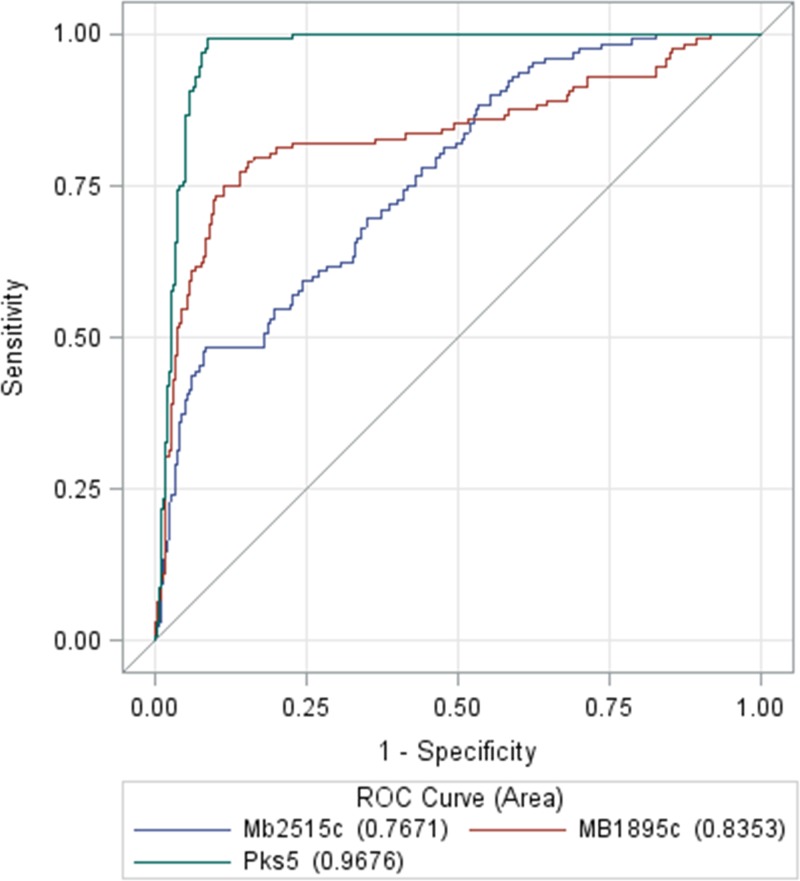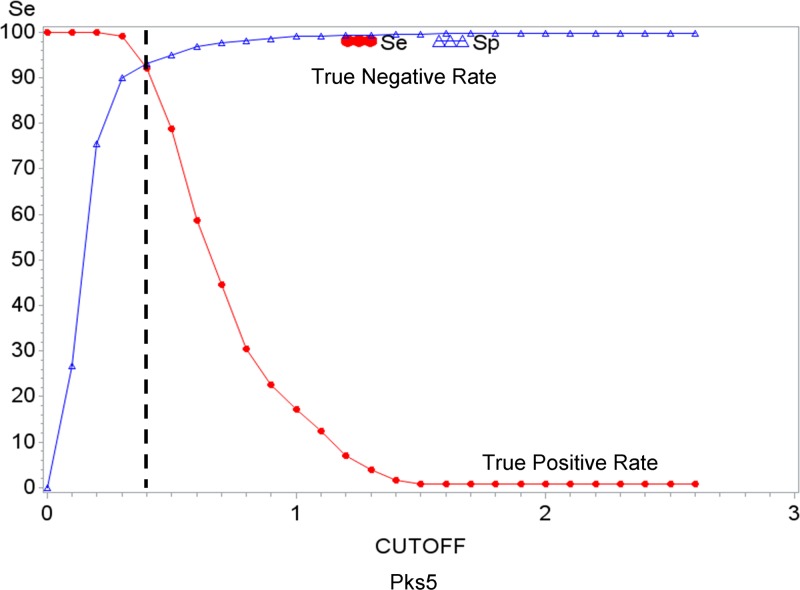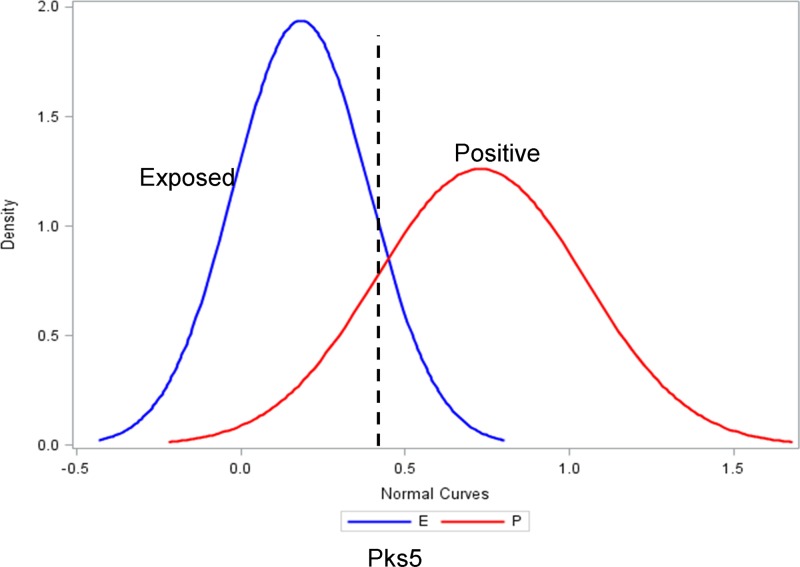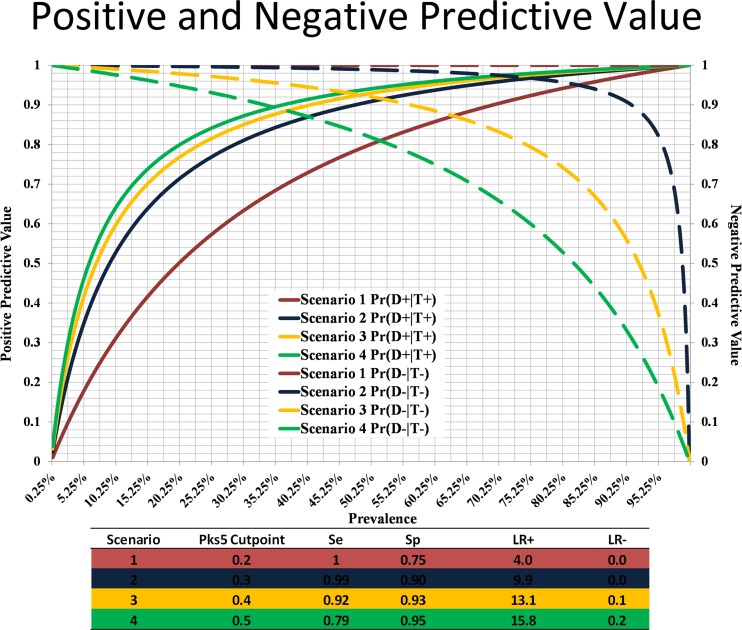Abstract
Bovine tuberculosis remains one of the most damaging diseases to agriculture, and there is also a concern for human spillover. A critical need exists for rapid, thorough, and inexpensive diagnostic methods capable of detecting and differentiating Mycobacterium bovis infection from other pathogenic and environmental mycobacteria at multiple surveillance levels. In a previous study, Seth et al. (PLoS One 4:e5478, 2009, doi:10.1371/journal.pone.0005478) identified 32 host peptides that specifically increased in the blood serum of M. bovis-infected animals). In the current study, 16 M. bovis proteins were discovered in the blood serum proteomics data sets. A large-scale validation analysis was undertaken for selected host and M. bovis proteins using a cattle serum repository containing M. bovis (n = 128), Mycobacterium kansasii (n = 10), and Mycobacterium avium subsp. paratuberculosis (n = 10), cases exposed to M. bovis (n = 424), and negative controls (n = 38). Of the host biomarkers, vitamin D binding protein (VDBP) showed the greatest sensitivity and specificity for M. bovis detection. Circulating M. bovis proteins, specifically polyketide synthetase 5, detected M. bovis-infected cattle with little to no seroreactivity against M. kansasii- and M. avium subsp. paratuberculosis-infected animals. These data indicate that host and pathogen serum proteins can serve as reliable biomarkers for tracking M. bovis infection in animal populations.
INTRODUCTION
A critical element in the prevention and control of bovine tuberculosis (bTB) is early and unambiguous diagnosis of subclinical infections. The majority of the diagnostic methods for subclinical infections rely on immune responses, which are confounded by previous exposure to the suspect pathogens and cross-reactivity with similar microbes and diseases. In order to develop next-generation diagnostics with improved accuracy, pathogen-specific biomarkers predictive of disease progression and outcome must be identified and validated.
bTB, a prevalent and devastating disease of cattle worldwide, caused by Mycobacterium bovis, is a classic example of detection failure and misidentification (1). The United States Department of Agriculture (USDA) bTB eradication program relies on three main tests: the caudal fold test (CFT), comparative cervical test (CCT), and a gamma interferon release assay (IGRA) (Bovigam; Prionics) (2). All three tests are labor-intensive and have logistical challenges and sensitivity/specificity issues. For example, the CFT lacks specificity for M. bovis infection and fails to detect all diseased cattle, which is further confounded by frequent background infection with a different pathogenic mycobacterium, M. avium subsp. paratuberculosis (3, 4). In addition, the IGRA requires blood samples to be processed within 24 h of collection, which may not be feasible with large herds located in areas where a specialized laboratory is not easily accessible (2). Furthermore, various studies suggest that the injection of tuberculin antigens used in the CFT may impact IGRA and result in false positives; however, additional testing is needed to confirm this (5, 6). Current testing limitations, significant economic losses, and spillover to human and wildlife populations highlight the urgency for a multifaceted test that increases detection, limits disease exposure, and distinguishes M. bovis infection from infections with other mycobacteria and diseases that impact animal and human health (7).
The elucidation and public availability of cattle and M. bovis genomes have advanced our understanding of the host responses to M. bovis and its genetic elements that may be regulated during infection (8, 9). Knowledge about response elements and gene regulation have allowed researchers to make refinements to diagnostics and discover approaches to aid in bTB detection (10). The host response measures utilized for bTB diagnostics include an array of cytokines, chemokines, and antibody responses to M. bovis proteins (5, 11). Although these tools provide another layer of testing, the results obtained are often confounded by cross-reactivity due to homology between mycobacterial species (12). Furthermore, host response testing relies on a single cutoff value for detection, which may not be applicable to the testing needs of all environments. For example, regions that are endemic for bTB require diagnostic methods with a high sensitivity to eliminate all infected cattle to control disease spread, while areas of low bTB prevalence may seek increased specificity to minimize false positives and avoid undue economic losses.
In order to minimize cross-reactivity, we identified 32 host and 16 pathogen circulating peptides that are unique to M. bovis infection and followed up over a 5-month period using a highly sensitive proteomics approach (13). During infection, Mycobacterium-specific proteins, peptides, DNA, and lipids are released into the circulation (14, 15) and are likely to provide unprecedented specificity to identify M. bovis infection. We hypothesized that a panel of biomarkers, including host and pathogen peptides, would establish a precise test to detect subclinical bTB infection. The three most abundant blood serum host proteins (vitamin D binding protein [VDBP], fetuin-A, and alpha-1 antitrypsin) and three pathogen peptides (MB1895c, MB2515c, and Pks5) identified by isobaric tag for relative and absolute quantitation (iTRAQ) were validated using a well-characterized cattle serum repository, which included confirmed cases of M. bovis (n = 128), bTB-exposed cases (animals that were in contact with bTB-positive cattle) (n = 424), and negative controls (n = 38). Based on our findings, we propose that the identification of circulating pathogen peptides and host response proteins in serum samples may augment diagnostics and help track disease progression across the spectrum for other pathogenic infections.
MATERIALS AND METHODS
Sample sources.
All cattle used in this study were housed according to institutional guidelines and approved animal care protocols at the National Animal Disease Center (NADC) (Ames, IA). Blood serum samples used for iTRAQ analyses were obtained from calves infected with M. bovis strain 1315 (1.0 × 106 CFU) at the NADC. M. bovis-infected calves were housed in a biosafety level 3 (BSL-3) facility. The serum samples were collected at baseline from M. bovis-infected calves and then prospectively for every month postinfection (p.i.) for 5 months. All calves were tested for disease-associated immune response parameters, clinical signs, and lesion characteristics identified at the time of necropsy. M. bovis-designated cattle were CFT positive and had lesion characteristics found at necropsy. Field samples from bTB-infected and bTB-exposed cattle and samples from cattle experimentally infected with M. avium subsp. paratuberculosis and M. kansasii were obtained from serum repositories at the National Veterinary Services Laboratory (NVSL) (United States Department of Agriculture, Ames, IA) and the National Animal Disease Center (NADC) (USDA, Ames, IA), respectively (12, 16). The field samples were collected from a single herd in California. The history of Johne's disease in this herd was indeterminate. The bTB infection status of each animal was confirmed by a combination of antemortem caudal fold tests, pathogen culture, and lesion histology at the time of necropsy. bTB-exposed animals were defined as animals that had contact with bTB-infected cattle but tested negative for bTB (i.e., were negative for CFT, histology, and culture). Negative controls were collected from a bTB-free dairy herd in Minnesota (a generous gift from Paul Rapnicki). The negative controls were defined as negative for M. bovis by culture, histology (at time of necropsy), and CFT and did not have a history of Johne's disease.
iTRAQ data analysis and interpretation.
In our previous study, serum samples from calves infected with M. bovis (n = 5) and M. avium subsp. paratuberculosis (n = 5) and contemporary controls (n = 5) were pooled in equal concentrations (100 μl of 100 μg/μl) and used in 4 individual iTRAQ experiments: (i) M. bovis infection versus contemporary controls, (ii) M. bovis infection versus M. avium subsp. paratuberculosis infection, (iii) early M. avium subsp. paratuberculosis infection, and (iv) late chronic M. avium subsp. paratuberculosis infection. A detailed description of the sample processing and analysis using iTRAQ was described by Seth et al. (13). Host-specific peptides and relative abundance (>95% confidence interval [CI]) were identified using the ProteinPilot software 2.0 and 2.01 (Applied Biosystems, Inc., Foster City, CA) and the nr_bos_CTM_20070802 FASTA database. Pathogen peptides were identified using the M. bovis strain AF122 genome. At least two unique peptides per protein were used as a cutoff for analysis (P < 0.05 and an error factor [EF] of < 2). The EF signifies the 95% CI for an average ratio: EF = 1095% CI, where the 95% CI is calculated by the formula (ratio × EF) − (ratio/EF).
Immunoblotting for host response-associated biomarkers during bTB infection.
All procedures were developed at room temperature (RT). Experimental field samples (128 confirmed bTB infected and 82 bTB exposed) and negative controls (n = 38) were spotted in duplicate and dried on 0.2-μm nitrocellulose membranes. The nitrocellulose membranes were blocked using 1× phosphate-buffered saline (PBS)–0.05% Tween 20 (TW20) containing 5% nonfat dried milk powder with subtle shaking for 1 h and washed 5 times in 1× PBS-TW20 in 5-min increments. The nitrocellulose membranes were separately incubated with rabbit polyclonal alpha-1-antitrypsin (Abcam, Cambridge, MA), goat polyclonal fetuin-A (M-17) (Santa Cruz Biotechnology, Inc., Dallas, TX), and mouse anti-human VDBP (R&D Systems, Minneapolis, MN) diluted 1:1,000 in PBS-TW20 containing 1% nonfat dried milk powder with shaking for 1 h and subsequently washed as described above. The binding of primary antibodies to serum was detected using a 1:10,000 dilution of anti-rabbit IgG (R&D Systems), anti-mouse IgG (R&D Systems), and anti-goat IgG (Santa Cruz Biotechnology, Inc., Dallas, TX) conjugated to horseradish peroxidase (HRP) incubated for 1 h with shaking, followed by 5 PBS-TW20 washes and development with Western Lightning enhanced chemiluminescence substrate (PerkinElmer, Waltham, MA) per the manufacturer's instructions. The membranes were imaged using simple biochemical acquisition from LabWorks 4.6 software (LabWorks, Inc., Costa Mesa, CA), and the raw density values were calculated.
Production of monoclonal antibodies against M. bovis-specific peptides present in the blood serum of animals infected with M. bovis.
MB2515c, MB1895c, and MB1554c (Pks5) antibodies were commercially produced by NeoBioScience (Cambridge, MA). The proteins were selected based on iTRAQ identification and potential for immunogenicity as determined by the literature. Briefly, peptides were designed for each protein using NeoBioScience software that considered hydrophilicity, flexibility, accessibility, rotation, surface-exposed probability, and antigenicity. A Basic Local Alignment Search Tool (BLAST) search was performed on M. bovis proteins to eliminate homologous sequences. Mice (n = 5 for each peptide) were initially injected intraperitoneally with a peptide emulsion (10 to 50 μg) and complete Freund's adjuvant (CFA) in sterile saline. The immunizations were repeated 2 times using incomplete Freund's adjuvant (IFA) and once using PBS in place of CFA in 14- and 21-day intervals postimmunization. Every 21 days, postimmunization blood samples were drawn from the mice and were tested against the appropriate peptides using an indirect enzyme-linked immunosorbent assay (ELISA). Each mouse was euthanized 61 days postimmunization and its spleen was harvested for splenocyte extraction. Splenocytes were fused with hybridomas, which were seeded into individual wells in a 96-well plate and screened by ELISA to detect positive clones. The clones 19-1-1 (MB1895c), 5-1-3 (Pks5), and 3-1-2 (MB2515c) were selected, subcloned by limiting dilution, and isotyped. The clones were expanded and the supernatant was collected. Monoclonal antibodies were kept at −70°C until further use.
Development of an indirect ELISA to detect M. bovis-specific peptides in blood serum.
bTB-confirmed (n = 128), bTB-exposed (n = 424), M. kansasii-infected (n = 10), M. avium subsp. paratuberculosis-infected (n = 10), and negative-control (n = 38) sera were individually diluted in 0.05 M carbonate-bicarbonate buffer (pH, 9.6) (Sigma-Aldrich, St. Louis, MO) at a 1:50 dilution for MB1895c and MB2515c detection and a 1:100 dilution for Pks5 detection, and 50 μl/well of each sample was transferred to separate wells in Nunc MaxiSorp flat-bottom ELISA plates. Each sample was plated in triplicate. The serum samples were allowed to absorb overnight at 4°C and the plates were washed thrice using 200 μl/well of PBS. The plates were blocked in 200 μl/well of Blocker Blotto in Tris-buffered saline (TBS) (Pierce, Rockford, IL) for 2 h at 37°C, washed thrice using 300 μl/well of 1× Femto PBS containing 0.05% TW20 (G-Biosciences, St. Louis, MO), and incubated with either 100 μl/well of a 1:5,000 dilution of MB2515c or MB1895c or a 1:10,000 dilution of Pks5 resuspended in a 1% solution of Blocker Blotto in TBS with 0.05% TW20 for 1 h at RT. The plates were washed as described above and incubated with 100 μl/well of goat anti-mouse IgG-HRP (Santa Cruz Biotechnology, Inc., Dallas, TX) diluted 1:5,000 in 1% Blocker Blotto in TBS with 0.05% TW20 for 1 h at RT and subsequently washed. The ELISA plates were developed with 100 μl/well of 1-Step Ultra 3,3′,5,5′ tetramethylbenzidine (TMB)-ELISA (Pierce, Rockford, IL) and incubated for 30 min at RT in the dark. The TMB reaction was stopped by adding 50 μl/well of 2 M sulfuric acid, and the optical densities at 450 nm (OD450) were recorded using the SpectraMax M2 microplate reader and software (Molecular Devices, Sunnyvale, CA). Positive cutoff values were calculated from the negative-control average and two standard deviations.
Statistical analysis.
To construct receiver operating characteristic (ROC) curves for each biomarker, the test results for each animal were averaged across the replicates and the respective coefficient of variation was calculated (see the supplemental material). The ROC curves for host response and M. bovis-specific biomarkers were compared using the area under the ROC curve (AUC). Two comparisons were performed, positive versus within-herd exposed negative controls (exposed) and positive versus not exposed negative controls (controls). The optimal cutoff values were calculated for each biomarker by maximizing specificity (Sp) and sensitivity (Se). The cutoff value units were based on optical density at 450 nm from ELISAs (pathogen biomarkers) and relative light units (RLU) from dot blot analyses (host biomarkers). For the best performing biomarker, positive predictive values (PPV) and negative predictive values (NPV) with respective cut point-specific likelihood ratios (LR) were calculated at 4 different optimal combinations of Se and Sp in order to develop a framework for a decision analysis algorithm in multiple scenarios of disease prevalence (17). ROC curves and sensitivity-specificity plots were generated using SAS 9.3 (SAS Institute, Inc., Cary, NC, USA).
RESULTS
VDBP distinguishes confirmed bTB field samples from uninfected and exposed cattle.
The top three candidates identified by our previous study, alpha-1 antitrypsin, fetuin-A, and VDBP, were validated for their diagnostic potential in a large-scale screen of control and M. bovis-infected cattle (13). A total of 248 animals (negative control [n = 38], confirmed bTB [n = 128], and bTB exposed [n = 82]) were tested for reactivity to alpha-1 antitrypsin, fetuin-A, and VDBP via dot blot analysis. The area under the ROC curve (AUC) determined that VDBP was the most reliable biomarker capable of differentiating negative and M. bovis-infected animals (Fig. 1 to 3; see also Fig. S1 and S2 in the supplemental material). The majority of the exposed cattle (81.4%) were categorized as bTB negative (Fig. 1 to 3; see also Fig. S1 and S2 in the supplemental material). Similar to VDBP, ROC analysis of fetuin-A showed a near-perfect separation (0.9949) between the negative controls and bTB-infected animals; however, separation between bTB-exposed and -infected animals decreased to 0.7741 (Fig. 1; see also Fig. S2 in the supplemental material). Although the alpha-1 antitrypsin AUC was 0.7967 for infected versus uninfected animals, a separation between the infected and exposed groups was not distinguished (AUC, 0.5425) (Fig. 1; see also Fig. S2 in the supplemental material). It is important to note that herds suspected to be infected with bTB likely will not include pristine animals (i.e., those that are uninfected and unexposed); therefore, we examined VDBP as a potential diagnostic marker, as the AUC for infected versus exposed animals was 0.8860 (Fig. 1). ROC analysis identified 5 cutoff ODs that retained high sensitivities and specificities, which ranged from 33.25 to 40.25 nm. The true-negative rate and true-positive rate were plotted against the OD cutoffs, and the optimal cutoff value was 38.50 nm, with a sensitivity of 80.597% and specificity of 81.7073% (Fig. 2 and 3). Together, these data show that VDBP is a reliable host biomarker that distinguishes negative, exposed, and bTB-infected animals.
FIG 1.
Receiver operating characteristic (ROC) curves for host biomarkers. Each point on an ROC curve is the fraction of bTB-positive cattle (true-positive rate) versus the corresponding fraction of negative bTB-exposed cattle (false-positive rate). VDBP is the most reliable biomarker (AUC, 0.8860), fetuin-A is a moderately reliable biomarker (AUC, 0.7741), and alpha-1 antitrypsin is an unreliable biomarker (AUC, 0.5425).
FIG 3.
Vitamin D binding protein distinguished bovine tuberculosis-positive and negative bTB-exposed animals. The true-negative rate and true-positive rate using VDBP as a biomarker were plotted against each other. The optimal cutoff value corresponded to 38.50 (raw density). The cutoff value corresponds to a sensitivity (Se) of 80.597% and a specificity (Sp) of 81.7073%.
FIG 2.
Vitamin D binding protein (VDBP) histogram. Relative densities were collected from negative bTB-exposed (n = 82) and bTB-infected (n = 128) animals. The cutoff value (38.50) was determined based on ROC analysis and the true-negative rate versus the true-positive rate.
iTRAQ identification of M. bovis-specific proteins.
Blood serum samples from five calves experimentally infected with M. bovis at 1 and 4 months p.i. and uninfected controls were pooled and analyzed by iTRAQ (13). Peptides were compared against those in the M. bovis strain AF2122 genome. iTRAQ analysis identified 16 unique M. bovis proteins present in serum samples from calves at 4 months p.i. (Table 1).
TABLE 1.
Proteins identified in serum samples from M. bovis calves 4 months p.i.
| Locus ID | Predicted function | Subcellular location |
|---|---|---|
| MB2515c | Transcriptional regulator (LuxR family) | Cytoplasm |
| MB0862 | Methyltransferase activity | Cytoplasm |
| MB1482c | Glucose metabolism | Cytoplasm |
| MB2883c | Aldehyde dehydrogenase activity | Cytoplasm |
| MB1929 | Redox activity | Cytoplasm |
| MB1886c | Redox activity | Cytoplasm |
| MB1192 | Hydrolase activity | Cytoplasm |
| MB2441c | Hydrolase activity | Cytoplasm |
| MB2275 | FAD binding activity | Cytoplasm |
| MB2122c | Transcriptional regulator | Cytoplasm |
| MB1672c | Conserved hypothetical protein | Cytoplasm |
| MB1554c (pks5) | Cell wall biosynthesis | Cytoplasm |
| MB1895c | Molybdenum ion binding | Extracellular |
| MB3729c | Conserved hypothetical protein | Periplasm |
| MB1268 | Transporter activity | Transmembrane |
| MB3017c | Isomerase activity | Transmembrane |
M. bovis proteins MB1895c, MB2515c, and Pks5 are present in bTB-positive and -suspected animals.
Three M. bovis proteins (MB1895c, MB2515c, and Pks5) identified in iTRAQ analysis were selected for antibody production. Field (bTB [n = 128], negative bTB-exposed [n = 428], and negative-control [n = 38]) animals were tested for detection with MB1895c, MB2515c, and Pks5 antibodies. The AUC show that all three pathogen markers easily distinguish negative from infected animals (Fig. 4). Pks5 showed the greatest separation of bTB-positive samples from bTB exposed and negative animals (see Fig. S3 and S4 in the supplemental material). The cutoff values from the ROC and true-positive and true-negative rate analyses determined that the maximum sensitivity (92.188%) and specificity (93.1604%) were achieved at 0.4 (OD450) (Fig. 4 to 6; see also Fig. S5 in the supplemental material). A Pks5 cutoff value of 0.3 (OD450) for the negative controls versus bTB-infected animals revealed increased sensitivity and specificity at 99.219% and 100%, respectively (Fig. 5; see also Fig. S6 in the supplemental material). However, as previously mentioned, herds suspected to be infected with bTB are likely to contain exposed bTB cattle rather than a truly negative population, and the application of a 0.3 cutoff may result in a number of false-positive animals. Indeed, when applied to bTB-exposed animals from this study, a 0.3 cutoff resulted in 10% of animals being designated bTB positive in comparison to 6% using a 0.4 cutoff. The MB1895c cutoff value that provided a separation between exposed and infected animals while retaining a high degree of specificity was 0.2 nm (see Fig. S7 in the supplemental material). MB2515c performed the poorest of all three pathogen markers, with the optimal cutoff value of 0.2 having a sensitivity of 69.531% and specificity of 64.151% (see Fig. S8 in the supplemental material). Together, these data show that circulating pathogen peptides are detected within M. bovis-infected animal serum, which may be utilized to distinguish control, exposed, and infected cattle.
FIG 4.
Receiver operating characteristic (ROC) curves for pathogen biomarkers. Each point on an ROC curve is the fraction of bTB-positive cattle (true-positive rate) versus the corresponding fraction of negative bTB-exposed cattle (false-positive rate). Pks5 is the most reliable biomarker (AUC, 0.9676), and MB1895c and MB2515c are moderately reliable biomarkers (AUC, 0.8353 and 0.7671, respectively).
FIG 6.
Pks5 distinguished bovine tuberculosis-positive and negative bTB-exposed animals. The true-negative rate and true-positive rate using Pks5 as a biomarker were plotted against each other. The optimal cutoff value corresponded to 0.4 nm. Cutoff value corresponds to a sensitivity of 92.188% and a specificity of 93.1604%.
FIG 5.
Polyketide synthetase 5 (Pks5) histogram. Relative densities were collected from negative bTB-exposed (n = 428) and bTB-infected (n = 128) animals. Cutoff value (0.4 nm) was determined based on ROC analysis and the true-negative rate versus the true-positive rate.
Application of Pks5 to detect bovine tuberculosis in a low-prevalence region.
The majority of infectious disease diagnostic methods rely on a single cutoff value to indicate infectious status. However, diagnostic requirements will differ between regions of low and high prevalence for bTB. Therefore, we determined the positive and negative predictive values of Pks5 to correctly diagnose bTB given disease prevalence (Fig. 2 and 3). Scenarios 1 and 2 define diagnostic test parameters applicable for bTB surveillance in a high-prevalence area, while parameters depicted in scenarios 4 and 5 apply to low-prevalence geographic locations. In regions of high-bTB prevalence, scenarios 1 and 2 are applicable given increased sensitivity, while low-prevalence areas require increased specificity (scenarios 3 and 4) (Fig. 7). The PPV for scenarios 1, 2 3, and 4 are as 1.0, 0.96, 0.9, and 0.8, respectively. The NPV are 1.0, 0.9, 0.99, and 0.98 for scenarios 1 to 4, respectively (Fig. 7). In order to determine the utility of Pks5 in a region that has low prevalence for bTB and the possibility of cross-reactivity with other pathogenic mycobacteria, we tested blood serum samples from cattle infected with either M. avium subsp. paratuberculosis or M. kansasii and considered the cutoff value from scenario 4 (Fig. 7). Nine out of 10 of M. avium subsp. paratuberculosis and nine out of 10 M. kansasii serum samples tested were categorized as being from uninfected animals under scenario 4 (low prevalence), and only 1 animal from each group was categorized as bTB infected (Table 2). The data suggest that multicutoff value testing based on prevalence will greatly aid bTB testing in various locations and that Pks5 is specifically shed, as there is minimal cross-reactivity with other pathogenic mycobacteria infections. Further testing using a larger number of M. avium subsp. paratuberculosis- and M. kansasii-infected animals will be required to validate biomarker specificity.
FIG 7.
Pks5 positive and negative predictive values and cutoff values based on bovine tuberculosis prevalence. Positive and negative predictive values were plotted against percent prevalence values. Cutoff values were assigned to 4 scenarios based on prevalence. Scenario 1, high bTB prevalence (red); scenario 2, moderate bTB prevalence (blue); scenario 3, moderate-low bTB prevalence (yellow); scenario 4, low bTB prevalence (green); Pr, probability; D(+/−), Disease or no disease; T(+/−), test result positive or negative.
TABLE 2.
Pks5 optical densities of cattle infected with M. avium subsp. paratuberculosis and M. kansasii
| Infection type | Cow no. | OD450a | Scenario 4 |
|---|---|---|---|
| M. avium subsp. paratuberculosis | 1 | 0.359367 | Uninfected |
| 2 | 0.3472 | Uninfected | |
| 3 | 0.1424 | Uninfected | |
| 4 | 0.3044 | Uninfected | |
| 5 | 0.7765 | Infected | |
| 6 | 0.0719 | Uninfected | |
| 7 | 0.1139 | Uninfected | |
| 8 | 0.3467 | Uninfected | |
| 9 | 0.0499 | Uninfected | |
| 10 | 0.0504 | Uninfected | |
| M. kansasii | 1 | 0.267767 | Uninfected |
| 2 | 0.336133 | Uninfected | |
| 3 | 0.1369 | Uninfected | |
| 4 | 0.3463 | Uninfected | |
| 5 | 0.086233 | Uninfected | |
| 6 | 0.1278 | Uninfected | |
| 7 | 0.729833 | Infected | |
| 8 | 0.105833 | Uninfected | |
| 9 | 0.049667 | Uninfected | |
| 10 | 0.083433 | Uninfected |
OD450, optical density at 450 nm. The optical densities were determined in triplicate, and the results are reported as the average for each cow/infection combination.
DISCUSSION
Exclusive reliance on host-related biomarkers of infectious disease is fraught with indeterminate results. This is largely due to cross-reactivity with similar pathogenic and environmental bacteria and other diseases (potentially those of a noninfectious nature).
In a previous report, using iTRAQ, we identified 32 blood serum proteins specifically upregulated in M. bovis-infected cattle. We have expanded our research to include testing of the top three host biomarkers in an extensive and well-characterized field cattle serum repository, including samples from experimentally infected and exposed cases of M. bovis. In order to increase testing specificity, we reinterrogated the iTRAQ data sets for M. bovis proteins with serum samples from infected animals. iTRAQ analysis identified 16 M. bovis proteins, of which 3 proteins were selected for further testing with sera from the M. bovis cattle repository, M. avium subsp. paratuberculosis-infected cattle, and M. kansasii-infected cattle. The pathogen proteins were selected based on their respective roles in pathogenesis and defense strategies (18–20). The identification and validation of host- and pathogen-specific proteins in the circulation will simplify current bTB diagnostics and the understanding of pathogenesis in M. bovis infection.
Potential biomarker candidates.
We tested three host blood serum proteins (VDBP, alpha-1-antitrypsin, and fetuin-A) and three pathogen proteins (MB2515c, MB1895c, and Pks5) in a large-scale validation analysis using well-characterized field serum samples from M. bovis-infected, bTB-exposed, and negative-control animals. We showed that VDBP is the most reliable host biomarker that is capable of distinguishing negative, infected, and negative bTB-exposed cases (Fig. 1; see also Fig. S2 in the supplemental material). Since our 2009 report, other researchers have identified VDBP as a potential biomarker for mycobacterial infection (21, 22). Tanaka et al. showed elevated VDBP levels within active tuberculosis patients compared to in the uninfected control group (22). VDBP has also been illustrated to be a biomarker that can be used to diagnose M. tuberculosis infection and examine immune responses in anthropological samples (21). We show here that fetuin-A may be used as a biomarker to differentiate M. bovis-infected and -uninfected animals, while alpha-1-antitrypsin is ineffective as a diagnostic marker (see Fig. S4 and S5 in the supplemental material). In addition to VDBP, Tanaka et al. (22) identified fetuin-A as consistently downregulated in active tuberculosis cases. Differences in fetuin-A expression between the Tanaka et al. report and our study may be explained by the sample source. For example, Tanaka et al. used serum samples from Japanese and Vietnamese populations, which have been noted to carry polymorphisms in the fetuin-A gene (23). Polymorphisms within fetuin-A may contribute to decreased expression in response to infection. In order to increase specificity, we reinterrogated iTRAQ data sets for M. bovis-specific proteins in infected animal sera. Selected pathogen proteins, MB2515c, MB1895c, and Pks5, were present in all infected animal serum samples. All three proteins were capable of distinguishing M. bovis-infected and -exposed cases from uninfected controls. Although all three pathogen peptides easily separated negative from infected animals, it is important to note that animals within a herd suspected to be infected with bTB are likely to be of an exposed status (i.e., have had contact with infected animals) rather than being truly uninfected. Thus, comparisons between bTB and negative animals have a lower cutoff value, which when applied in the field, generates a higher false-positive rate. Therefore, we examined the ability of each pathogen marker to differentiate between infected and exposed animals (Fig. 4). Pks5 retained a high AUC, and we propose that this marker be used to aid current bTB testing strategies.
Pks5 application in the field.
Current testing strategies (CFT, IGRA, and CCT) are based on a single cutoff value to diagnose bTB infection, regardless of prevalence. Under the single cutoff, CFT has a sensitivity of 84.9% and specificity of 89.2% (24). While the comparative cervical test (CCT) has a sensitivity of 74% and a specificity of 96%, the IGRA has a sensitivity of 83.9% and a specificity of 90.7% (25, 26). It is important to note that a “one-size-fits-all” testing method is not appropriate for all regions, states, and countries, and that the available diagnostic methods do not reflect this. For example, in the United States, bTB affects <0.1% of all herds, and diagnostic methods with a cutoff based on high sensitivity may designate animals that were exposed to other mycobacteria (e.g., M. avium subsp. paratuberculosis) as being bTB positive. Misidentification will negatively impact the agricultural economy of a low-prevalence area, and cutoff values should be based on specificity. In contrast, in areas with a high prevalence of bTB, it may be beneficial to have testing cutoffs with increased sensitivity to capture all infected cattle and minimize potential spillover to other animals and humans. Therefore, Pks5 cutoffs were determined based on scenarios for high-prevalence (scenarios 1 and 2) and low-prevalence (scenarios 3 and 4) areas (Fig. 7). Areas that are endemic for bTB (high prevalence) are reflective of locations, such as China, India, and Africa, which practice intense farming conditions (i.e., have high animal densities in limited space and/or shared or close living quarters with humans) and where active control programs are scarce or inadequate. Current diagnostic methods lack sufficient sensitivity to capture the majority of bTB-infected animals; therefore, there is substantial concern that bTB will spread to other animals within the herd, neighboring herds, and potentially to humans. bTB transmission to humans is also enhanced under these conditions given that high-prevalence areas typically associated with developing countries do not enforce the pasteurization of milk and milk products (27). Thus, bTB animals that are not identified under available diagnostic methods will continue to be employed for milk production and impact human health. Examples of areas with low bTB prevalence are the United States and Canada, in which active control and surveillance programs are in place and farming practices are adjusted to meet control program recommendations and guidelines as well as availability for education/training for farmers. Under the current bTB testing strategy, M. avium subsp. paratuberculosis-infected or vaccinated cattle are likely to test CFT positive and result in an unnecessary economic loss for the farmer. Furthermore, not all bTB-exposed cattle will become infected or progress to subclinical infection and later clinical disease. This would result in the undue culling of valuable animals. Therefore, the economic well-being of the farmer should be valued, and increased specificity should be utilized. Although our results indicated that Pks5 may serve as a diagnostic tool for M. bovis infections, the possibility remains that these proteins might react with other pathogenic mycobacteria. Therefore, we tested serum samples from animals infected with M. avium subsp. paratuberculosis and M. kansasii (Table 2). We show limited cross-reactivity of Pks5 with M. avium subsp. paratuberculosis- and M. kansasii-infected sera (Table 2). The results from this study as well as the scientific literature indicate that VDBP, fetuin-A, MB1895c, MB2515c, and Pks5 can be used as a panel of biomarkers to aid in current M. bovis diagnostics.
Although host and pathogen blood serum proteins serve as diagnostic biomarkers of M. bovis infection, tests in the form of dot blots and ELISAs are not feasible in the field. The goals of any diagnostic method are to have sensitive, specific, and rapid results as well as ease of testing. We propose that the application of an appropriate point-of-care/testing device such as a nanosensor microfluidic apparatus or portable surfaced-enhanced Raman spectroscope using these biomarkers may be more convenient and provide better throughput (28, 29).
Supplementary Material
ACKNOWLEDGMENTS
We thank the Center for Mass Spectrometry and Proteomics at the University of Minnesota for technical advice. We thank the American Society for Microbiology Writing and Publishing Institute and Steven R. Blanke, University of Illinois at Urbana-Champaign, for advice on manuscript preparation. We also thank the National Veterinary Services Laboratory, Ames, IA, for sharing serum samples from their well-defined repositories that contribute significantly to the development of the serological diagnosis of subclinical bovine tuberculosis. We acknowledge Paul Rapnicki, University of Minnesota, for his kind gift of bTB-negative serum samples. We thank Beth Harris and Jeffery Nelson at the NVSL for critical reading and comments on the manuscript.
This study was funded by the Minnesota Rapid Agricultural Response Fund (Minnesota Agricultural Experiment Station), the Morris Animal Foundation Wildlife Fund (D14ZO-086), and the USDA (grant 61-4056A, awarded to S.S.).
Footnotes
Published ahead of print 4 December 2013
Supplemental material for this article may be found at http://dx.doi.org/10.1128/JCM.02433-13.
REFERENCES
- 1.Essey MA, Koller MA. 1994. Status of bovine tuberculosis in North America. Vet. Microbiol. 40:15–22. 10.1016/0378-1135(94)90043-4 [DOI] [PubMed] [Google Scholar]
- 2.USDA-APHIS 2005. Bovine tuberculosis eradication: uniform methods and rules, effective January 1, 2005. Animal and Plant Health Inspection Service, U.S. Department of Agriculture, Washington, DC: http://www.aphis.usda.gov/animal_health/animal_diseases/tuberculosis/downloads/tb-umr.pdf [Google Scholar]
- 3.USDA-APHIS 2008. Johne's disease on U.S. dairies, 1991–2007. Animal and Plant Health Inspection Service, U.S. Department of Agriculture, Washington, DC: http://www.aphis.usda.gov/animal_health/nahms/dairy/downloads/dairy07/Dairy07_is_Johnes.pdf [Google Scholar]
- 4.Köhler H, Gyra H, Zimmer K, Dräger KG, Burkert B, Lemser B, Hausleithner D, Cubler K, Klawonn W, Hess RG. 2001. Immune reactions in cattle after immunization with a Mycobacterium paratuberculosis vaccine and implications for the diagnosis of M. paratuberculosis and M. bovis infections. J. Vet. Med. B, Infect. Dis. Vet. Public Health 48:185–195. 10.1046/j.1439-0450.2001.00443.x [DOI] [PubMed] [Google Scholar]
- 5.Waters WR, Thacker TC, Nonnecke BJ, Palmer MV, Schiller I, Oesch B, Vordermeier HM, Silva E, Estes DM. 2012. Evaluation of gamma interferon (IFN-γ)-induced protein 10 responses for detection of cattle infected with Mycobacterium bovis: comparisons to IFN-γ responses. Clin. Vaccine Immunol. 19:346–351. 10.1128/CVI.05657-11 [DOI] [PMC free article] [PubMed] [Google Scholar]
- 6.Whipple DL, Palmer MV, Slaughter RE, Jones SL. 2001. Comparison of purified protein derivatives and effect of skin testing on results of a commercial gamma interferon assay for diagnosis of tuberculosis in cattle. J. Vet. Diagn. Invest. 13:117–122. 10.1177/104063870101300204 [DOI] [PubMed] [Google Scholar]
- 7.Zinsstag J, Schelling E, Roth F, Kazwala R. 2006. Economics of bovine tuberculosis, p 68–83 In Theon CO, Steele JH, Gilsdorf MJ. (ed), Mycobacterium bovis infection in animals and humans, 2nd ed. Blackwell Publishing, Boston, MA [Google Scholar]
- 8.Garnier T, Eiglmeier K, Camus JC, Medina N, Mansoor H, Pryor M, Duthoy S, Grondin S, Lacroix C, Monsempe C, Simon S, Harris B, Atkin R, Doggett J, Mayes R, Keating L, Wheeler PR, Parkhill J, Barrell BG, Cole ST, Gordon SV, Hewinson RG. 2003. The complete genome sequence of Mycobacterium bovis. Proc. Natl. Acad. Sci. U. S. A. 100:7877–7882. 10.1073/pnas.1130426100 [DOI] [PMC free article] [PubMed] [Google Scholar]
- 9.Zimin AV, Delcher AL, Florea L, Kelley DR, Schatz MC, Puiu D, Hanrahan F, Pertea G, Van Tassell CP, Sonstegard TS, Marcais G, Roberts M, Subramanian P, Yorke JA, Salzberg SL. 2009. A whole-genome assembly of the domestic cow, Bos taurus. Genome Biol. 10:R42. 10.1186/gb-2009-10-4-r42 [DOI] [PMC free article] [PubMed] [Google Scholar]
- 10.Thacker TC, Harris B, Palmer MV, Waters WR. 2011. Improved specificity for detection of Mycobacterium bovis in fresh tissues using IS6110 real-time PCR. BMC Vet. Res. 7:50. 10.1186/1746-6148-7-50 [DOI] [PMC free article] [PubMed] [Google Scholar]
- 11.Blanco FC, Bianco MV, Meikle V, Garbaccio S, Vagnoni L, Forrellad M, Klepp LI, Cataldi AA, Bigi F. 2011. Increased IL-17 expression is associated with pathology in a bovine model of tuberculosis. Tuberculosis (Edinb) 91:57–63. 10.1016/j.tube.2010.11.007 [DOI] [PubMed] [Google Scholar]
- 12.Waters WR, Palmer MV, Thacker TC, Payeur JB, Harris NB, Minion FC, Greenwald R, Esfandiari J, Andersen P, McNair J, Pollock JM, Lyashchenko KP. 2006. Immune responses to defined antigens of Mycobacterium bovis in cattle experimentally infected with Mycobacterium kansasii. Clin. Vaccine Immunol. 13:611–619. 10.1128/CVI.00054-06 [DOI] [PMC free article] [PubMed] [Google Scholar]
- 13.Seth M, Lamont EA, Janagama HK, Widdel A, Vulchanova L, Stabel JR, Waters WR, Palmer MV, Sreevatsan S. 2009. Biomarker discovery in subclinical mycobacterial infections of cattle. PLoS One 4:e5478. 10.1371/journal.pone.0005478 [DOI] [PMC free article] [PubMed] [Google Scholar]
- 14.Green C, Huggett JF, Talbot E, Mwaba P, Reither K, Zumla AI. 2009. Rapid diagnosis of tuberculosis through the detection of mycobacterial DNA in urine by nucleic acid amplification methods. Lancet Infect. Dis. 9:505–511. 10.1016/S1473-3099(09)70149-5 [DOI] [PubMed] [Google Scholar]
- 15.Pollock NR, Macovei L, Kanunfre K, Dhiman R, Restrepo BI, Zarate I, Pino PA, Mora-Guzman F, Fujiwara RT, Michel G, Kashino SS, Campos-Neto A. 2013. Validation of Mycobacterium tuberculosis Rv1681 protein as a diagnostic marker of active pulmonary tuberculosis. J. Clin. Microbiol. 51:1367–1373. 10.1128/JCM.03192-12 [DOI] [PMC free article] [PubMed] [Google Scholar]
- 16.Stabel JR, Palmer MV, Harris B, Plattner B, Hostetter J, Robbe-Austerman S. 2009. Pathogenesis of Mycobacterium avium subsp. paratuberculosis in neonatal calves after oral or intraperitoneal experimental infection. Vet. Microbiol. 136:306–313. 10.1016/j.vetmic.2008.11.025 [DOI] [PubMed] [Google Scholar]
- 17.Dohoo I, Wayne M, Stryhn H. 2009. Veterinary epidemiologic research. VER, Inc., Prince Edward Island, Canada [Google Scholar]
- 18.Chen J, Xie J. 2011. Role and regulation of bacterial LuxR-like regulators. J. Cell. Biochem. 112:2694–2702. 10.1002/jcb.23219 [DOI] [PubMed] [Google Scholar]
- 19.Chopra T, Gokhale RS. 2009. Polyketide versatility in the biosynthesis of complex mycobacterial cell wall lipids. Methods Enzymol. 459:259–294. 10.1016/S0076-6879(09)04612-6 [DOI] [PubMed] [Google Scholar]
- 20.Williams MJ, Kana BD, Mizrahi V. 2011. Functional analysis of molybdopterin biosynthesis in mycobacteria identifies a fused molybdopterin synthase in Mycobacterium tuberculosis. J. Bacteriol. 193:98–106. 10.1128/JB.00774-10 [DOI] [PMC free article] [PubMed] [Google Scholar]
- 21.Corthals A, Koller A, Martin DW, Rieger R, Chen EI, Bernaski M, Recagno G, Dávalos LM. 2012. Detecting the immune system response of a 500 year-old Inca mummy. PLoS One 7:e41244. 10.1371/journal.pone.0041244 [DOI] [PMC free article] [PubMed] [Google Scholar]
- 22.Tanaka T, Sakurada S, Kano K, Takahashi E, Yasuda K, Hirano H, Kaburagi Y, Kobayashi N, Hang NTL, Lien LT, Matsushita I, Hijikata M, Uchida T, Keicho N. 2011. Identification of tuberculosis-associated proteins in whole blood supernatant. BMC Infect. Dis. 11:71. 10.1186/1471-2334-11-71 [DOI] [PMC free article] [PubMed] [Google Scholar]
- 23.Lee PL, West C, Crain K, Wang L. 2006. Genetic polymorphisms and susceptibility to lung disease. J. Negat. Results Biomed. 5:5. 10.1186/1477-5751-5-5 [DOI] [PMC free article] [PubMed] [Google Scholar]
- 24.Gaborick CM, Salman MD, Ellis RP, Triantis J. 1996. Evaluation of a five-antigen ELISA for diagnosis of tuberculosis in cattle and Cervidae. J. Am. Vet. Med. Assoc. 209:962–966 [PubMed] [Google Scholar]
- 25.Antognoli MC, Remmenga MD, Bengtson SD, Clark HJ, Orloski KA, Gustafson LL, Scott AE. 2011. Analysis of the diagnostic accuracy of the gamma interferon assay for detection of bovine tuberculosis in U.S. herds. Prev. Vet. Med. 101:35–41. 10.1016/j.prevetmed.2011.05.012 [DOI] [PubMed] [Google Scholar]
- 26.USDA:APHIS 1992. Assessment of risk factors for Mycobacterium bovis in the United States. USDA:APHIS:VS, Centers for Epidemiology and Animal Health, Fort Collins, CO [Google Scholar]
- 27.Firdessa R, Tschopp R, Wubete A, Sombo M, Hailu E, Erenso G, Kiros T, Yamuah L, Vordermeier M, Hewinson RG, Young D, Gordon SV, Sahile M, Aseffa A, Berg S. 2012. High prevalence of bovine tuberculosis in dairy cattle in central Ethiopia: implications for the dairy industry and public health. PLoS One 7:e52851. 10.1371/journal.pone.0052851 [DOI] [PMC free article] [PubMed] [Google Scholar]
- 28.Sathyavathi R, Dingari NC, Barman I, Prasad PS, Prabhakar S, Narayana Rao D, Dasari RR, Undamatla J. 2012. Raman spectroscopy provides a powerful, rapid diagnostic tool for the detection of tuberculous meningitis in ex vivo cerebrospinal fluid samples. J. Biophotonics 6:567–572. 10.1002/jbio.201200110 [DOI] [PMC free article] [PubMed] [Google Scholar]
- 29.Wadhwa A, Foote RS, Shaw RW, Eda S. 2012. Bead-based microfluidic immunoassay for diagnosis of Johne's disease. J. Immunol. Methods 382:196–202. 10.1016/j.jim.2012.06.006 [DOI] [PubMed] [Google Scholar]
Associated Data
This section collects any data citations, data availability statements, or supplementary materials included in this article.



